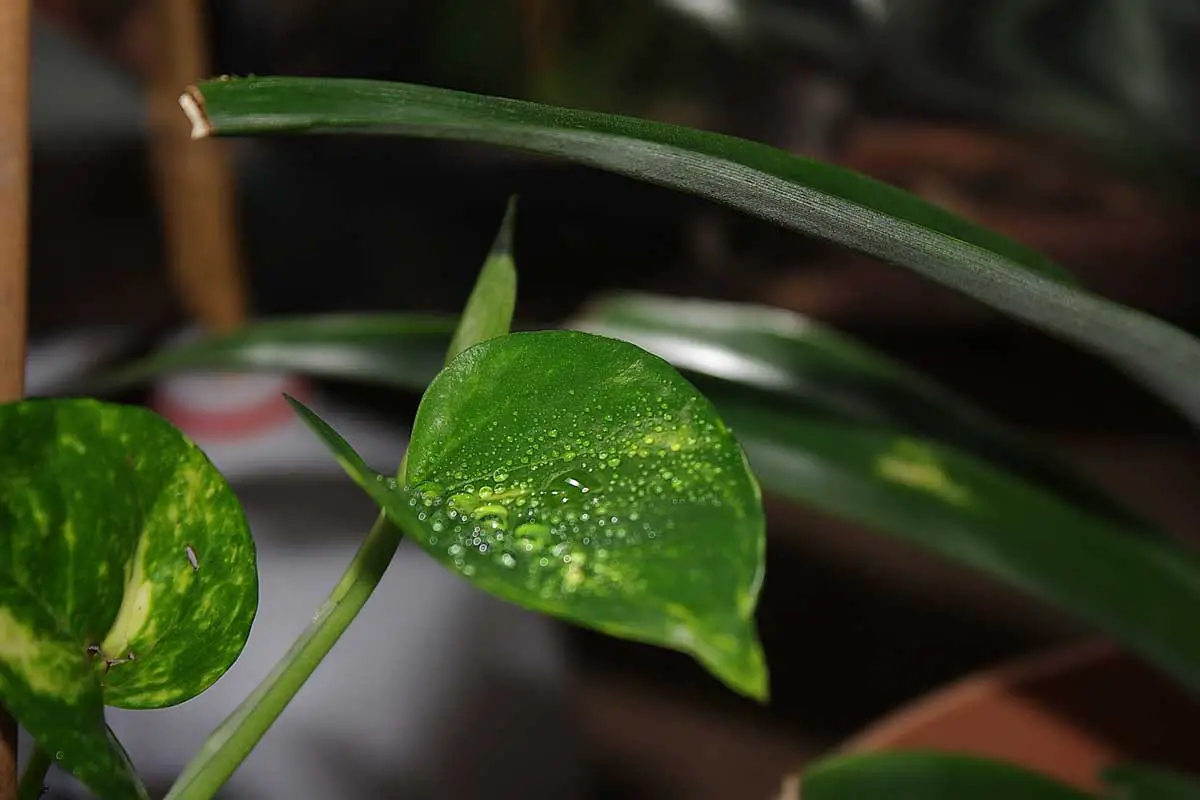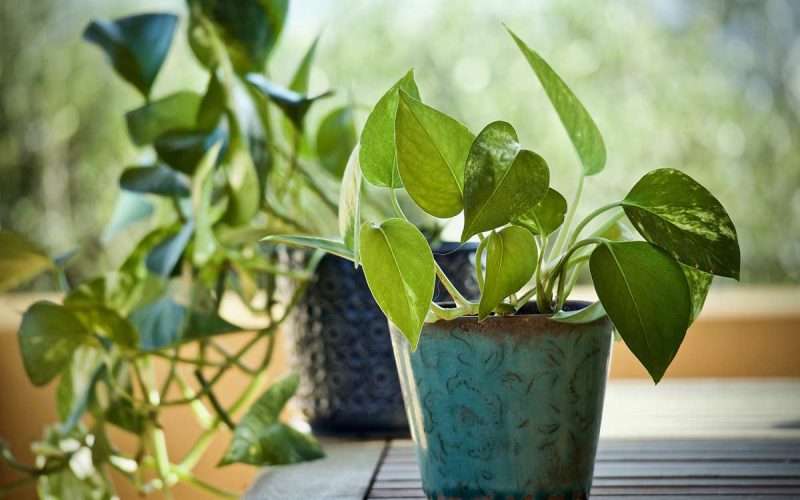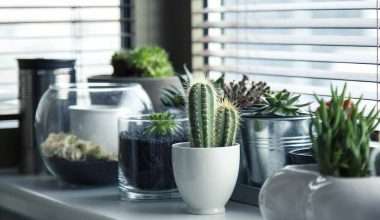Table of Contents Show
Epipremnum aureum also known as the houseplant pothos is a species native to Mo’orea in French Polynesia. These indoor vine plants are very famous due to their low maintenance. Heart-shaped leaves with trailing stems are favorites for shelves and hanging baskets.
Epipremnum aureum is the only natural species of pothos while the rest are cultivars developed by horticulturists. Hybrids of pothos don’t exist, every other existing variety is a cultivar of the natural pothos.
An interesting fact about pothos is that they are excellent air cleaners. Pothos can get rid of some commonly found toxins in rooms such as VOC benzene which many types of plants and furniture give off.
How do you take care of Pothos plants?
All the varieties share some traits while there are differences between them as well. Despite that, they do share the same basic care requirements.
They are easy to care for plants and do not require much attention but some tips will come in handy:
Light Requirement
The leaves may change color depending on light exposure. Pothos can survive low light conditions but they prefer bright indirect light.
Water
Drooping leaves indicate thirsty pothos. It’s better to dry out the soil before watering. Pothos can also survive inconstant watering.
Soil Requirement
The soil must have good drainage. Mixing coconut coir or perlite will help you get better drainage. Pothos prefer slightly acidic soil. pH in the range of 6.1 to 6.5 will do, although there won’t be any problems with neutral.
Feed
Pothos won’t trouble you much when it comes to feeding. Providing a well-balanced fertilizer every 2-3 months is enough. Avoid overfeeding to prevent toxication effects in plants.
Temperature
A suitable temperature range for pothos would be 70oF – 90oF (21- 31oC). It may survive low temperatures but can’t tolerate temperatures below 55oF (13oC)
Blooming
Pothos is a flowering plant in the wild but you must treat it with special hormones for it to bloom indoors.
Hydroponics
Pothos doesn’t require a special method for hydroponics. A simple method such as the Kratky method is fine as well that is putting the plant in a simple vase or jug.
Size
The maximum height it can reach is between 6ft to 10 ft although they are easily trimmed.
Propagation
They are very easy to propagate plants. You can directly follow the stem cutting method and can either directly pot it or root it in the water.
List of Pothos To Plant
We have selected and put into the list several different varieties of pothos that you consider adding to your indoor plants.
1. Epipremnum Aureum (Golden Pothos)

The most common variety is the Golden pothos. The name is partly due to its colors but not because the leaves are golden. The leaves have an emerald green color with dabs and dashes of yellow scattered across the leaves.
It is one of the most easily available varieties of pothos that can be found in any small plant shop or garden center. If your friend has one of these, simply cut a stem and pot it in your house to grow your own.
It can adapt to any environment easily so it is advised to use it as a background to have this lovely vibe. It’s better to not use it as a center-stage plant, it will do best on a shelf or a cupboard spreading freshness with its discreet and beautiful presence.
Some fresh air outside in the summer season would be nice for the golden pothos.
2. Epipremnum Aureum ‘Marble Queen’
Marble queen is a center-stage plant, unlike the golden pothos. It is very popular among the varieties of this tropic vine.
The color of the leaves has an astonishing combination of white and green in the form of marble-like patches. Some leaves may have more white than green due to a lack of chlorophyll, but this gives the plant a little more texture.
Lack of chlorophyll also limits its growth rate which in turn makes it an even better choice for a table plant. A slow growth rate gives it more of a sculptural value with less required maintenance.
It will look perfect in a modern style setting where it can serve its purpose as a decorative sculpture. An ideal scenario would be to have it in a 1960s-style room filled with pop art.
Try to avoid keeping it in low light conditions because it may produce more chlorophyll to compensate for the conditions which can result in the loss of its white.
3. Neon Pothos
This variety got its name from its color. Neon pothos has the brightest green color which makes them shine more than other pothos. The color starts as light green but changes to neon green as they mature.
Neon pothos is also very well known for its perfectly heart-shaped leaves. The shiny neon color with perfect heart-shaped leaves makes it a favorite for a desk plant.
Neon pothos also gets on well in the background on a shelf in a culturally furnished room or a room with bold lines and colors for aesthetics.
Make sure to receive bright indirect light. Lack of light triggers a physiological reaction and the plant starts producing more chlorophyll which will darken the collar of neon pothos.
4.Epipremnum Aureum ‘Manjula’
Manjula pothos was originally cultivated and patented by the University of Florida. This means no one has the right to reproduce this variety makes it rare.
The leaves are heart-shaped but don’t stay flat like other pothos varieties, instead they curve down a bit from the tip. It’s a variegated plant and the color ranges from white to green through silver and cream.
The colors don’t have a definite pattern and can occur in any shape or combination. The colors strike as an abstract art making it perfect for rooms of formal or modern settings.
Since the plant itself is rare and expensive, you have to take extra care. Provide a balance between dark and light, and move it around often for light if necessary.
5. Epipremnum Pinnatum ‘Cebu Blue’
This variety doesn’t belong to Epipremnum aureum but Epipremnum pinnatum. Cebu blue is a plant for collectors which also makes it a rare one among its notional cousins or sisters.
The leaves have a dark blue-green color shade with a glossy almost metallic appearance. They are arrow-shaped with rich textures giving them an exotic (tropical forest-like) look.
Cebu blue goes well against dark wood. It will also be a great choice to put it along with other lush plants. It doesn’t require extra care, but make sure to avoid low temperatures when dealing with this variety.
6. Epipremnum Aureum ‘Jessenia’
Jessenia pothos is a delicate and variegated variety. The colors are two close shades of green, one is dark emerald while the other is chartreuse.
Some leaves also have colors in between these two shades and you won’t find any two similar-looking leaves. Jessenia pothos doesn’t lose its colors easily making it a great choice for different light conditions.
It may not have a striking appearance, but it is an ambiance creator due to its delicate aura. Put it in a place where it is not center-staged, but is in plain sight so its beauty can be appreciated at close range.
7. Epipremnum Aureum ‘Hawaiian’
An exotic cultivar with variegated leaves, this variety of pothos is popular for its tropical forest-like appearance. The leaves have rich emerald green color along with yellow-green splotches on them that follow lateral veins and draw the toward leaf edges.
It also grows aerial roots which add to its tropical forest-like appearance. The best way to use Hawaiian pothos would be to put them among other showy plants that can create a tropical forest corner in the room.
It’s best to regularly prune it, which will result in thicker foliage adding to the lush tropical forest-like look of the plant.
8. Scindapsus Pictus ‘Trebi’
Even though Trebi pothos isn’t a part of the same genus, it is still counted as one because of its similarities with pothos. You can spot this variety labeled as pothos among other pothos in garden centers and shops.
The leaves are heart-shaped with a resemblance to a lanceolate shape, the tip of the leaves bend sideways. These trailing vines have patterned leaves of two colors. The green color serves as a foundation while the silver-green fills the area as patches, splots, or dots.
Trebi pothos is not so easy to find and it’s better to put it against a dark or light monochrome background. A monochrome background will help you make the best out of its leaf patterns. It can go with both formal and informal room settings.
9. Epipremnum Aureum ‘Glacier’
Due to the sculptural qualities and small size, this cultivar is becoming a fairly popular and common variety in garden centers. The small size of this cultivar makes it an ideal choice for office desks and coffee/study tables.
Glacier pothos has a broad and soft-looking pattern of cream white and emerald green on the leaves. Trim it regularly to maintain its elegance. The light conditions should be checked because lowlights will cause extra production of chlorophyll and the whites will start to fade.
10. Epipremnum Aureum ‘N-Joy’
N-joy is a recently developed cultivar and is quite young among pothos. It has variegated leaves with clear green and white patches. Their patterns/patches seem like ink sketches on a leaf-shaped canvas.
The green color changes shade according to the light conditions and maturity of the leaf. It will transition from pale-green to dark. The sketches like patterns also have interesting shapes, sometimes it’s a butterfly and sometimes it will look like a flame inside a heart.
Place it on low-level shelves or hanging baskets to keep it in sight. This will help you make the best out of its sculptural qualities and lush foliage.
It’s not an easy-to-find plant, so the best way to acquire it would be to look for it online.
11. Scindapsus Pictus (Satin Pothos Or Silver Pothos)
Another rare variety of pothos that can only be found online due to its rarity. It has many striking and exotic features which justify its rarity.
Silver/Satin pothos bloom occasionally unlike other pothos varieties. The bloom is beautiful and exotic and resembles that of a pinecone or a strange tropical fruit. Their color can have many different shades of green but it’s usually matt green with spots of lighter green all over it.
The foliage is hanging from the stem giving off a vibe of dappled light from under a canopy of some tropical forest tree. This plant is definitely a center-staged variety and must be kept in plain sight so its beauty can be appreciated.
12. Epipremnum Aureum ‘Pearls And Jade’
One of the classiest types of this indoor plant is the pearl and jade pothos. The grace of a butterfly’s wings or the movement of a silk scarf gives it a charm that none other has.
The leaves are variegated and have cream white and green colors in them. The patterns are elegant with smooth transitioning colors, like paintings drawn with watercolors. Although most leaves follow sort of the same pattern which is, green in the middle and white on the sides. Sometimes it can have green lines around the edges as well.
The color green is of jade tone varying from bright to very intense and dark. It’s a center-staged plant, which must be placed in plain sight. An ideal room setting would be a Japanese-themed room with a neutral background.
Pearls and Jade must receive bright light, low lights will cause the green to spread over cream parts due to extra chlorophyll which will be produced by the leaves.






